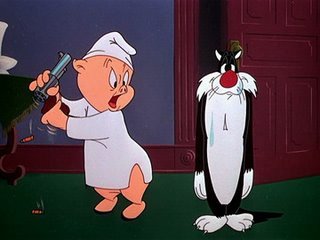 These are drawings made up entirely of 40s animation principles. Starting with very strong construction. All the characters are made of simple sphere, pear and tube shapes. I say simple, but that doesn't mean it's easy to put them together so well.
These are drawings made up entirely of 40s animation principles. Starting with very strong construction. All the characters are made of simple sphere, pear and tube shapes. I say simple, but that doesn't mean it's easy to put them together so well. Note that every character is the same design as Tom and Jerry and only superficial details that define the characters' species are differentiated. The chicken has feather and a comb. The dog has jowls. The pig has a snout and pig ears, etc...but everything else about them is exactly the same, just like Tom and Jerry. It made sense as animators were learning all the difficulties and principles of movement that they kept the characters fairly simple to draw - and solid, so they could easily turn them around in all dimensions. Many early characters hadn't evolved individual character designs yet. But they had everything else important to animating and clarity.
Note that every character is the same design as Tom and Jerry and only superficial details that define the characters' species are differentiated. The chicken has feather and a comb. The dog has jowls. The pig has a snout and pig ears, etc...but everything else about them is exactly the same, just like Tom and Jerry. It made sense as animators were learning all the difficulties and principles of movement that they kept the characters fairly simple to draw - and solid, so they could easily turn them around in all dimensions. Many early characters hadn't evolved individual character designs yet. But they had everything else important to animating and clarity. Clear Staging/composition
Clear Staging/compositionhttp://johnkstuff.blogspot.com/2009/01/disney-principles-staging-3-make-your.html
 Silhouettes
Silhouettes Opposing Poses
Opposing Poseshttp://johnkstuff.blogspot.com/2006/11/composition-7-compose-your-poses.html
 The one stylistic statement that is consistent in this comic is that all the perspective in the backgrounds is rounded. Round streets, round fences and houses etc. This was a standard early 30s cartoon style and you don't see it in many 40s cartoons.
The one stylistic statement that is consistent in this comic is that all the perspective in the backgrounds is rounded. Round streets, round fences and houses etc. This was a standard early 30s cartoon style and you don't see it in many 40s cartoons.This Eisenberg comic is pure Tom and Jerry style.
 By the 1940s, most of the advanced studios had gone past this pure, rounded spheres and pears approach and were starting to vary their character designs, background designs and some directors' styles were becoming very individual.
By the 1940s, most of the advanced studios had gone past this pure, rounded spheres and pears approach and were starting to vary their character designs, background designs and some directors' styles were becoming very individual. Bill and Joe hung on to this basic early 40s style longer than anybody.
Bill and Joe hung on to this basic early 40s style longer than anybody.  Joe himself was reluctant to change as long as his cartoons were popular and winning Academy Awards. He didn't start creating individual characters with their own unique designs until forced into television. Then he hired Ed Benedict who gave the Hanna Barbera studio a style and a cast of individual characters on the cheap.
Joe himself was reluctant to change as long as his cartoons were popular and winning Academy Awards. He didn't start creating individual characters with their own unique designs until forced into television. Then he hired Ed Benedict who gave the Hanna Barbera studio a style and a cast of individual characters on the cheap.Harvey Eisenberg continued drawing the HB comic books and strips and his style gradually became more individual
 and he mixed it with Ed's later.
and he mixed it with Ed's later. That was goodbye to pure pears and spheres (Preston Blair) and hello to more complex shapes, curves and angles,
That was goodbye to pure pears and spheres (Preston Blair) and hello to more complex shapes, curves and angles,  but it was not goodbye to good solid drawing principles. Not yet.
but it was not goodbye to good solid drawing principles. Not yet. http://johnkstuff.blogspot.com/2009/05/eisenberg-subtleties-studies.html
http://johnkstuff.blogspot.com/2009/05/eisenberg-subtleties-studies.htmlhttp://comicrazys.com/2010/01/15/petey-pinfeathers-red-rabbit-comics-7-1948-harvey-eisenberg/

The point of this article: Learn Your Principles First,
and then style will come.
http://johnkstuff.blogspot.com/2008/09/good-cartoonist-can-adapt-to-different.html
Hey and lots of thanks to all the students and fans who contributed to the cartoon lessons. If you folks do any of the lessons, remind me and I will give you some tips:




